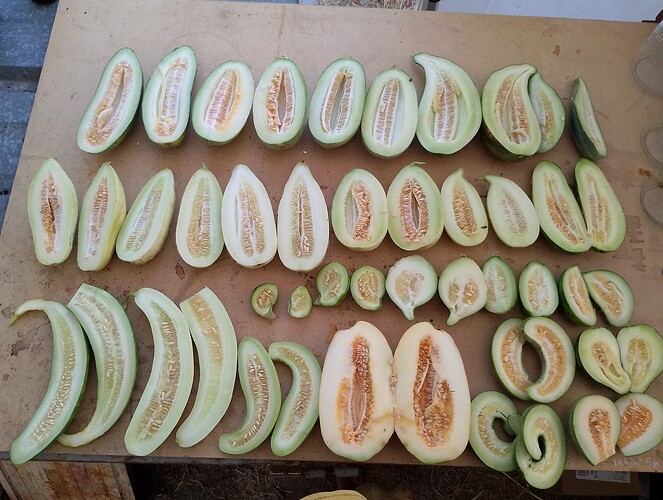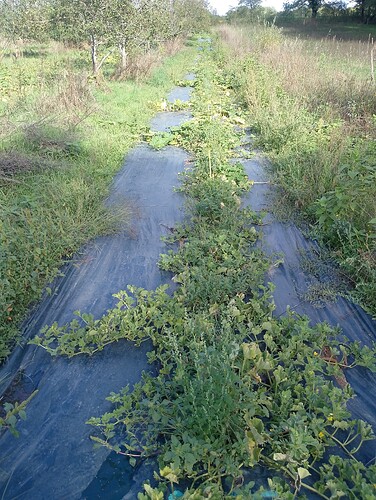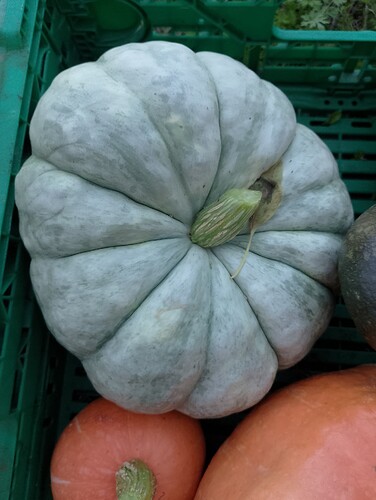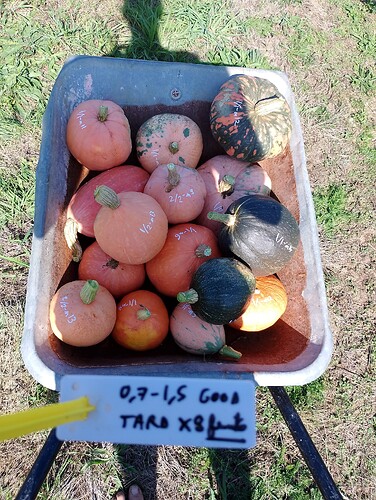Cucumber-melon population : main types and the whole population, overripe for fresh use, ready for seed extraction
Hmmm do they cross with cucumbers??
No no they are of the melon species (cucumis melo), so crossing with melons
Melon tasting today. 4 days of harvest tasted together.
I’m gonna press the juice of the best of them, drink it during the next days, and then the “rejected’ melon "(“so-so” taste) are going in a jar to do vinegar, possibly to try some distillation at some point.
There are some rrrreally good ones ![]()
Cucumber melons open, super crunchy, never bitter… I love them!
Also those ovals can remain for a while on the vines without losing their crunchiness! ![]()
I’ll keep seeds of those separated.
As melons it’s a species having a hard time on my acidic sansy soil, subject to powdery mildew.
what a massive and early harvest ! Great job guy ![]()
in order to understand the difference in my garden with your seeds:
What are your monthly rainfall readings since May?
What are your watering frequencies and quantities?
Are you fertilizing?
Hi Stephane,
it’s gonna be more about the plastic tarp than anything else I guess as we’ve had zero significant rain since mid June, i.e. maximum 30mm, and I’m not irrigating where there is the plastic tarp, i.e. where are those melons and watermelons on nearly 300m2 of my local garden.
End of may beginning of june was kind of humid (peobably 80mm cumulated), early may was dry, with no rain.
It’s a really sandy soil with very low organic matter, so kind of incapable of holding water. In that regards the tarp helps to retain some water.
Other “garden” being at a friend’s place : 700m2 with plastic tarp too and zero irrigation as well. But his soil, even if originally very similar to mine, is so damaged and crazily compacted after 15 years of surface tilling that it’s a whole other story regarding yields… but there I got no melons nor watermelons, only squash. They look miserable.
So’: to sum it up: zero input (but yes a year lawn rototilled in april could be considered as one organic one, as much as would be my cover crops in other parts), zero watering, low organic matter, and sandy soil. Yields are:
- Watermelons minimum 4 to 4,5kg/m2 depending on planting densities (2 versus 4plants/m2)
- Melons 1,8-2kg/m2 (same story…)
I didn’t do any early selection on vigor this year, but yes there has been already 2 rounds of heavy selection on that before, so that could be at play, maybe some local adaptation.
Regarding watermelon yesterday was the craziest harvest day of the year: 295kg… just 2 days after the last harvest! But it’s coming to an end for these as there is leftover 100-150kg in the field, not mature… so 640kg already harvested yet on this 180square meter patch… with no weeding no irrigation nothing… kind of crazy.
Yesterday’s harvest:
I’ve made an experimental design this year to assess if I could make a (partial) living out of that… so I select for taste out of those and then do side products, all fermented, using the juice. I’m in contact with people doing sorbets, kombuchas, kefir and diverse stuff.
incredible yield… ![]()
I think that the 80mm of rain in June arrived for you just at the right stage. It was at this moment that most of my feet died or got stuck because we already had a heatwave.
So you also start to reap the fruits of your work ![]() … your seeds are clearly adapted to your field and work… that’s also why they don’t work here because I’m in another climate and soil.
… your seeds are clearly adapted to your field and work… that’s also why they don’t work here because I’m in another climate and soil.
Your genetic bottlenecks in previous years could be eliminated from the genetics that might have worked here in my context. ![]()
For the moment I should rather go look for melon genetics in Syria, Afghanistan, Mexico… ![]() still 35°c at noon !
still 35°c at noon !
Hey Stephane thanks for your return but no - or your climate and soil is very super special - : I got super good results with my watermelons both in Haute-Saône, Haute-Loire, Lozère on soils being very different from mine - except Lozère. Also tested against Sugar Baby in some places: they do good, best in general in terms of growth at least.
I’m still very early in selection (actually last year was the first after 2 of wild wild grex) and so I don’t imagine any bottlenecks.
Also I never cultivated less than 500 hundred plants in total (a thousand in total this year, 600 just on the tarp) and my last year selection was very gentle: just getting rid of those with no good taste at all.
Nonetheless yes it’s certain I have selected towards some local adaptation vua early vigor selection (as last year was 100% direct sowing with that heavy selection at 3 weeks post sowing)… but nevertheless it’s direct sowing when all modern selection is made post sowing in trays and transplants… so there must be also some added benefits of that in general. I mean something like root architecture, ability to “make friends” in a “natural” soil… Or at least it’s my guess ![]()
How are your tomatoes doing, @ThomasPicard ?
Gonna check them next week. Most supposedly mildew resistant + some not known but tested for that + but some really wide ranging genetics. Some rare ones are doing very well, some have already collapsed. About 300 plants. Some are super high yielding too.
I got also direct sown tomatoes and (hot) peppers from Jesse selected first on vigor and early fruiting, and then LB resistance and taste. I see little to no LB resistance in those. Hot peppers will be only selected on fruiting as 95-99% won’t have gone to seed in end September when I get rid of all plants. Still it’s something like 15 plants who will have fruited.
Are you selecting for determinate tomatoes? I see that you’re not using any support to keep them up except the cucurbits. I’m growing them the same way this year and I’m curious how it effects selection. In one bed where the companion plant is much smaller, some tomatoes get too large and eventually bend over breaking.
I must say that I don’t really select tomatoes, so I’m not very intentionnal about it, nor very attentive to it. I only just pre-select strains for a network willing to create plain fields tomato populations by crossing varieties already tolerant to resistant to LB.
I’m not specifically pre-selecting for determinate types, but I would be enclined to say that what you describe is consistent with what I’m seeing: this kind of STUN method revealing inherent capabilities that you wouldn’t see by cuddling them…
You’re just a bloodthirsty butcher! ![]()
I’m going to file a complaint at the Watermelon Protection League. ![]()
At my friend’s place on plastic tarp. Vines want to regrow now after suffering a bad bad drought in the worse soil ever: even in my bad soil yield would have been at least doubled.
Surprisingly enough in those conditions moschatas seem earlier: their peduncle being dryer compared to maxima,
MAXIMAS
Maximas harvested at my place over the past days
A lot more than at my friends place even if, as you can directly see from pics, rows 2-3-4 suffered a lot from last year’s bad soil management (bare soil with dwarf cucurbitas and no irrigation…). 15 rows in total.
A usual row of 16 plants filling a wheel barrow like that:
So 235 fruits from my about 240 plants. Rare produced 2 fruits, most produced 1, some none. Challenging environment with my “summer cover crop” which took over the field, I had no time weeding so I let it grow… let’s say ironically that I will make a “double harvest’ with amaranths ![]() , there is also some chia and possibly mung beans to harvest in there… not talking about eggplants and other tomatoes or physalis I need to get back to.
, there is also some chia and possibly mung beans to harvest in there… not talking about eggplants and other tomatoes or physalis I need to get back to.
So to summarize 2025 growing season, in comparison to moschatas (still to harvest):
… 100% direct sowing on the 20th of May + culling to just one plant out of 10 seeds sown at 3 weeks post sowing…
… A spectacular early growth comparatively to moschatas around: I was even afraid that moschata would not fruit that much after a month of growth… eventually those in same conditions will do a double yield, minimum…
…A challenging environment (ph5.2), sandy soil… zero input…
… Some irrigation from mid july to end August… but none from mid June to mid July, so when needed during those awfull heatwaves (my neighbours wasn’t willing to turn it on during that period…).
… An experimental cover crop sown around the 12th of June to protect the soil… cut in mid july, regrew after… now from size level to 6 feet high… I believe that in that challenging environment it created more competition than collaboration. If it had been a wet season like 2024 it would have been different… That’s my guess… Also if I had been there from mid june to mid july I would have cut it a first time which have prevented cucurbits to be drowning under the cover crops… that was somehow a noticeable blow to them in parts of my fields, searching for light, water, etc.
… Eventually around 40% of the plants were entirely dead at harvest, which contrasts a lot with moschata in neighbouring fields, in same challenging conditions : all alive, no disease or so little, and a quarter of them still sprawling, and which also highlights the fragility of maxima. Of those entirely dead plants, with brown dried vines, more than half of them left immature fruits.
Of those 60% “still alive” I should say that a best way to describe it would be “not entirely dead” : only a few leaves surviving but most under imminent collapse… the very rare still sprawling and flowering carry no fruit on their vines.
Another fact from that year’s crop : I decided to pull out all plants to look for a causal or corollary factor of that overall weakness that could be related their underground structure, comparatively to moschatas, and in that field to some interspecific hybrids whose genetics were 75% moschatas (Tetsukabuto post last year’s growth in a moschata patch) and something has been made clear from that :
- maximas have a weaker primary root system : easier to pull out + having less to none fine root branching around the main roots.
- maximas have a much smaller capacity to reroot along the vine.
Is that the result of intense breeding of maximas in a high input + heavy tillage over the past century? But why moschatas would be so different? Hasn’t heavy tillage + NPK + plastic mulch been the standard over the past 50 years?… Is it more a signature of the species? I would imagine that, and we already know from Brent Loy that as a species maximas have a much smaller diversity compared to moschatas… It’s like a dwarf genome in comparison… I also know they come from more temperate regions (Argentina vs Tropics)… I can’t know anything for the main points, but I’m gonna ask the University of New Hampshire cucurbit team about that to know more: about roots and about overall strategies to bring resistance in maximas.
And if you know crazily resistant varieties of maximas please please please… let me know!!!
And now the fruits will be staying on a shelf in a barn until end december… possibly getting mild frosts in december… I won’t cuddle these intentionnally, as I will do taste evaluation and selection only of those left intact.
I’ve filled a database along my harvest, so we will be able to know for certain (and not just in theory!) if plant health (roots, leaves…) transcribes to more intense flavors, more complex aromas… great taste! And to longer storage capacities I’ll be able to do other corollaries I’ll tell you about by then.


















